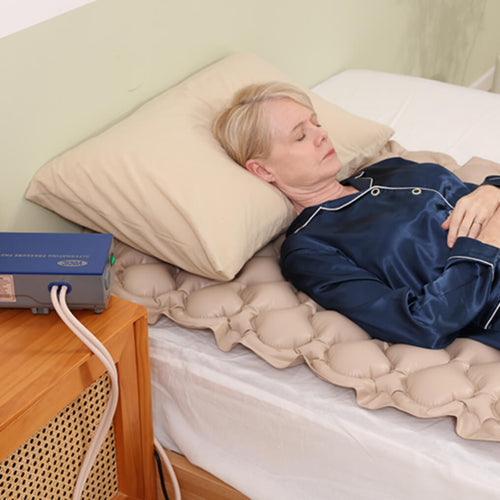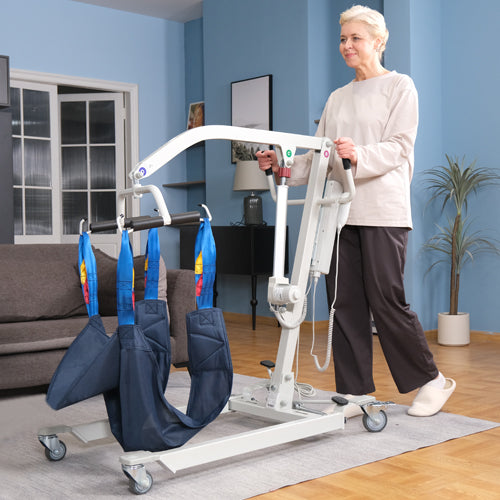Moving people with limited mobility, such as those in a bed, up to a chair, wheelchair, or toilet, cannot be easy or safe without the appropriate support.
That is where a patient lift transfer chair at home will be a necessary assistant. These electric or manual tools assist the caregivers in transporting patients with ease, safety, and without physical exertion.
Regardless of whether you are attending to a loved one at home or dealing with the post-surgery recuperation, understanding how these devices function and what characteristics you should seek will either make or break the difference between comfort and safety.
What is a Patient Lift Transfer Chair?
A patient lift transfer chair for home is a mobility aid device that aids the lifting and transfer of patients between surfaces, e.g., a bed, wheelchair, car seat, or toilet without using heavy lifting.
Such chairs are either electrically powered or hydraulically powered to help raise and lower the users smoothly. The majority of contemporary models are intended to be used by one person; thus, they can be assisted by the caregiver or a family member without professional intervention.
Patient lift chairs differ from traditional wheelchairs in that their use is not aimed at independent mobility, but rather for safe, ergonomic transfers that lower the risk of injury to both patients and caregivers.
Why are Patient Lift Transfer Chairs Important?
Such chairs play a very important role in the home care setting by:
- Primary prevention of manual lifting injuries in caregivers.
- Helping patients who have extreme mobility issues, either due to paralysis or post-stroke status.
- Facilitating safe transfers between the bed, toilet, and car.
- Minimizing the risk of falls and discomfort during transitions.
- Promoting more autonomy and comfort for the user.
They cover the difference between comfort at home and medical-grade care to ensure that long-term care can be managed safely without involving hospitalization.

Key Features to Look for in the Best Patient Lift Transfer Chairs
There are certain things keep an eye out for when purchasing a chair such as this:
Safety Features and Stability
Safety is the top priority in any lift system. Look for models that include emergency stop features, caster wheel locks, anti-tip frames, padded seats, or slings that provide full-body support.
The VOCIC AY06 Electric Patient Lift will be a great option here; it has emergency lowering capability, overload protection, and a strong aluminum frame that is firmly attached and locks firmly during the transfers.
Weight Capacity and Durability
Weight capacity dictates how safely a lift can be used. The majority of the high-quality models can carry a weight of 300 to 450 lbs.
The VOCIC AY06 Electric Patient Lift is ideally used by most patients, as it can tolerate up to 300 lbs, and is lightweight and can be folded up to be used at home.
Other key features include:
- Handheld remote controlled smooth electric lift arm.
- Easy transport and storage, with a foldable design.
- 360° swivel base for easy positioning.
- Rechargeable battery lasting 8-12 hours of usage.
Portability and Storage
Since space is often limited in home environments, portability becomes an essential feature. Foldable frames make it easy to store the lift when not in use or transport it conveniently in a car trunk.
The AY06 is compact and can be completely folded, ideal for families who need reliable assistance at home or on the go.
Ease of Use and Adjustability
A friendly and convenient control system would ease the burden during transports. Adjustable height and arm positioning allow the lift to align easily with beds, cars, and wheelchairs.
The adjustable head of the AY06 (18-65 inches) allows it to fit under most standard beds and car seats, the lightweight frame itself can be folded up and reassembled by a single person.
How to Effectively Use a Patient Lift Transfer Chair for Home
- Position the chair correctly: Place the lift chair close to the patient’s current seating area (bed, wheelchair, or toilet).
- Secure the sling or seat: The straps should be fastened in an even manner to avoid tilting.
- Activate the lift: Use the remote to raise or lower the arm gradually.
- Lock the wheels: Lock all the wheels to ensure no movement takes place prior to the transfer.
- Assist gently: It is necessary to make sure that the patient is safe and stable prior to movement.
These measures are supportive in keeping things safe and comfortable while reducing the effort for caregivers.

Complementary Mobility Aids for Home: Hoyer Lift and Lift Chair
A home-based patient lift transfer chair can be enhanced with other devices, such as Hoyer lifts or electric lift chairs, to enhance overall function.
One of the best devices to use in full-body transfers and bariatric support is the VOCIC AY02 Electric Full-Body Hoyer Lift. It has a weight capacity of 440 lbs, and the ability to lift directly from the floor, making it ideal for the task of rescuing patients or fallen individuals.
Key advantages include:
- 360° rotating sling hook for precise positioning.
- Adjustable base width (24-34 inches) for easy access under beds and chairs.
- Emergency stop and manual lowering crank for added safety.
- Quiet 24V DC motor and tool-free assembly.
To get something smaller, has a seat, and is an electric chair lift, the VOCIC AX35 Movable Electric Chair Lift with 4 Wheels will fit the seat. It is constructed specifically to serve patients who are capable of sitting upright but require a boost to be transferred.
Highlights include:
- 350 lbs. weight capacity and T-shaped base for superior stability.
- 4 large, smooth-rolling wheels for short-distance transfers.
- Hand control for smooth electric seat adjustment.
- Push handle for easy caregiver movement.
The AY02, together with the AY06 and AX35, will make up a complete product line, including full body recovery, home and car-ready compact seated transfer.
Conclusion
Choosing the right patient lift transfer chair for home is based on how much space you have, the needs of the user, and the degree of health practitioner intervention. The transfers by electric models such as VOCIC AY06 are easier, safer, and less physical. With heavier users, the AY02 provides hospital-tier power, whereas the AX35 provides families with a seated and portable version, ideal in emergency situations.
By investing in the appropriate equipment, you are guaranteed comfort, safety, and independence for the patient and the caregiver. Making the right electric lift chair is not the only thing that will make daily routines easy, but it will also restore dignity and freedom of movement at home.
FAQ
What is the first step when preparing to transfer a patient?
Always make sure there is stability of the lift and the area is clear. Lock the wheels, seal the sling or seat, and communicate with the patient, then move.
How to transfer a patient from a chair to a bed?
Take the lift near the chair, hook up the sling, and lift the patient using the remote, and turn the sling rather softly towards the bed, then lower until the patient is in a comfortable sitting position.
How does a patient lift transfer chair work?
It operates on an electric lift or a hydraulic lift to make users go up and down safely. Other models, such as the VOCIC AY06, are also controlled through a handheld remote and thus can be used to transfer one person to another surface easily.
Will Medicare pay for a lift chair for older people?
Medicare Part B will cover medically necessary lift mechanisms ordered by a physician, which are usually covered, but not always. You must always verify your plan and supplier eligibility.









